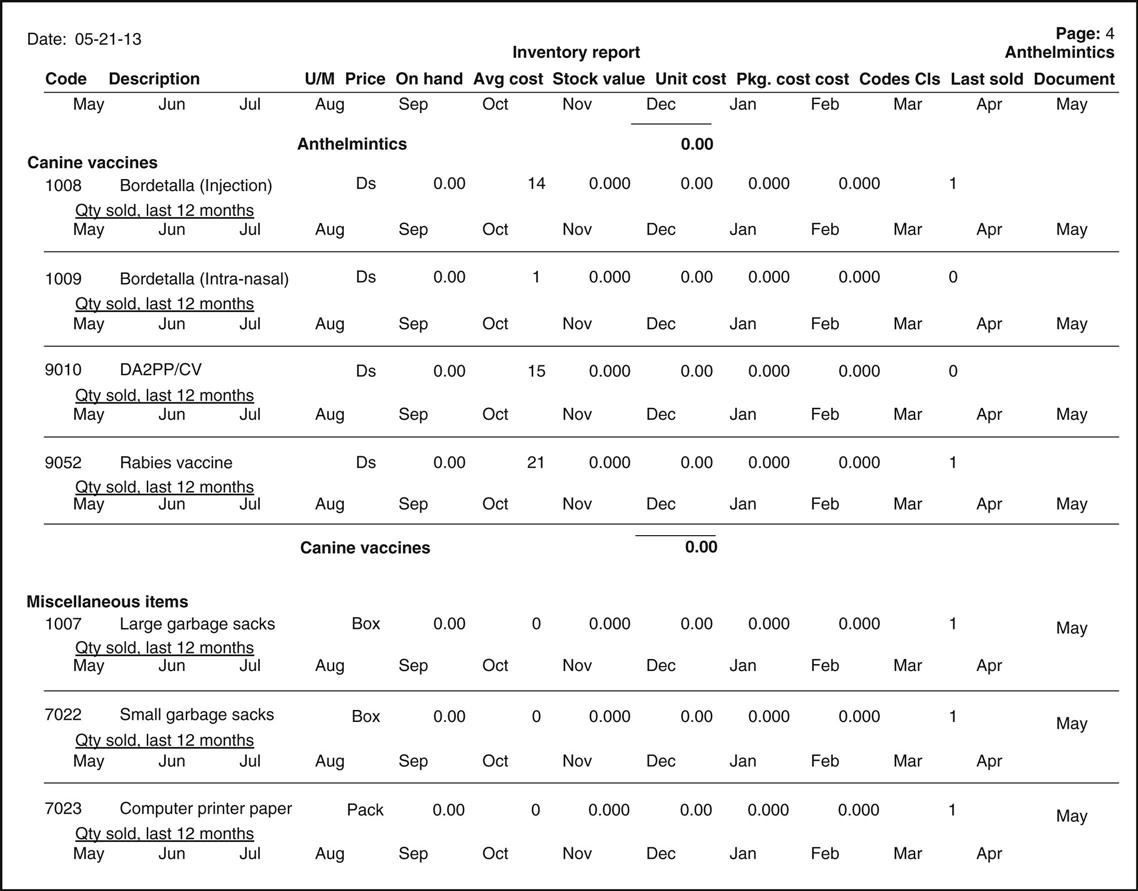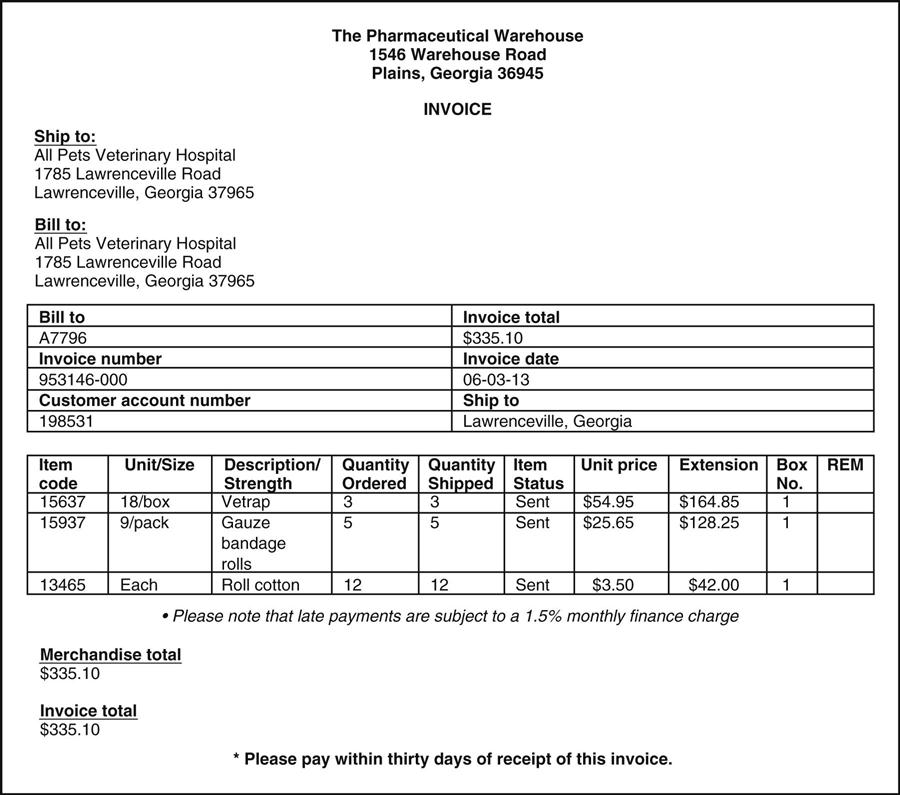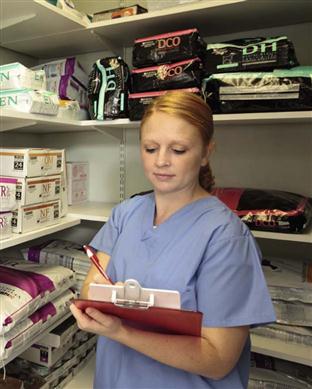Inventory
The Veterinary Technician’s Role
Learning Objectives
After studying this chapter, you should be able to
1. Explain why having an inventory control system is important.
2. Describe ways in which inventory control benefits a business.
3. Explain why inventory turnover is important.
4. Discuss ways of becoming an efficient inventory control manager.
5. Describe various inventory record-keeping systems.
6. Describe the differences in vendor types.
7. Describe good communication techniques that can be used with sales representatives.
8. Discuss ways that veterinary management computer software aids in tracking pharmaceutical inventory.
Key Terms
Average cost of inventory on hand
DEA form
Delayed billing
FIFO
FOB
FOB destination
FOB shipping point
Full-service company
Inventory
Inventory control manager (ICM)
Invoice
Mail order discount house
Markup
Packing slip
Statement
Turnover
Veterinary supply distributor
Introduction
Control of inventory is an important concern for companies both large and small, and veterinary businesses are no exception. Proactively maintaining pharmaceutical inventory is an ongoing endeavor for veterinary hospitals (Figure 19-1). Deciding how much trade or generic name product to buy, keeping expired items off the shelves, and performing a physical inventory are all integral parts of keeping a veterinary facility functioning as a healthy business. When a product is depleted before the next order arrives, it is frustrating for both veterinary staff and the clientele. When a product is not available, it cannot be sold and no profit can be made. Deciding which employee to entrust with this responsibility is an important decision for veterinary practice owners that should be made with careful consideration. Therefore, the employee chosen for this job should treat the position with respect and make every effort to be frugal with the employer’s money.
The veterinary technician often is the employee chosen to perform this job. Therefore, knowledge of pharmaceutics and the ability to observe quantities of product used within a month are important talents that the veterinary technician must possess.
In our technologically advanced society, pharmaceutics change rapidly because new products are constantly being developed. The veterinary technician who is charged with being the ICM must be willing to learn about new products and to pass this information on to the entire veterinary staff. Communication and good people skills are useful when one is dealing with pharmaceutical sales representatives. Sales representatives are invaluable to veterinary practices because they are armed with all available information about drugs, both old and new.
The ICM has many responsibilities. These responsibilities include keeping the staff informed regarding discontinued items, knowing the dates on which backordered items will be released from the vendor, packing up goods awaiting return to the vendor (e.g., expired items), rotating stock correctly, maintaining current prices on all products, organizing inventory for ease of location and counting, receiving and inspecting orders on arrival at the veterinary facility, and learning about new products. These are only a few of the responsibilities the ICM will meet daily. Inventory should be handled as an ongoing process. Each day, inventory must be visually counted, and physical inventory must be done at least once a month for good results.
Inventory
Accounting of inventory items is very important when one is filing income taxes or in the event of a fire or natural disaster. Veterinary practices providing an accurate inventory of their business assets are assured that their insurance companies will reimburse the business accurately should a disaster occur. The primary goal of inventory is to have sufficient quantities of inventory available to serve clients’ needs, while at the same time minimizing the cost of carrying that inventory. Purchasing too many units of a slow-selling item can cost the practice money, and not purchasing enough of a high-selling item can result in the item being out of stock, which can cause frustration (Libby, Libby, and Short, 2004) for the veterinary team.
An accounting system plays three roles in the inventory management process:
Thus, what exactly is the definition of inventory? It is tangible property that is sold in the normal course of a business day. In veterinary medicine, this would include such items as antibiotics, anthelmintics, shampoos, topical medications, prescription feeds, and even the dispensing bottles used to dispense liquid medication, as well as the syringes sold to clients that they must use to orally medicate their pets at home. Dispensing bottles, syringes, needles, ointment tins, and so forth could be classified as raw materials because they are carriers for the actual medicine that is being prescribed and dispensed. However, raw materials cost the practice money, just as pharmaceutics do. It is just as frustrating to run out of these items as it is to run out of a broad-spectrum antibiotic.
Most veterinary practices use the first in, first out (FIFO) method of inventory. This is not necessarily done by choice but rather because of the expiration dates on merchandise that the practice sells. Generally speaking, the expiration date that is the earliest should be sold first. A perpetual inventory control system, which is a detailed record for each type of merchandise stocked, shows the following:
• Units and costs of the beginning inventory
• Units and costs of each purchase
• Units and costs of the goods for each sale
Luckily, most veterinary computer management software programs do the above listed items automatically. In today’s business world, inventory is much easier to keep up with than it was in the days of periodic inventory, when businesses did not have computers (Libby, Libby, and Short, 2004). However, it is better to use a balance between a perpetual inventory control system and a periodic inventory because sometimes the amount of each item listed within the computer system may not be a true reflection of what is actually on hand. Nothing can ever take the place of a periodic inventory and physically counting the amount of each item on hand. The primary disadvantage of a periodic inventory system is the lack of inventory information that is available to the practice owner; that is, veterinary management software makes inventory easier because it shows up-to-date amounts of each item sold, along with trends during the summer or winter months that can help staff in deciding how much inventory needs to be purchased in the coming years.
Inventory is an ongoing process, and trends within the practice must be observed daily. The ICM must be able to recognize the products that each veterinarian in the practice uses and dispenses, to ensure that items are on hand when needed. Nothing is more frustrating than needing a drug or other inventory item to treat a patient with, only to find it is not in stock. Computer software designed for the veterinary business can help tremendously with tracking trends within the practice. Most software has the ability to provide printouts of day-by-day, week-by-week, month-by-month, and yearly sales trends (Figure 19-2).

Through establishment of a workable inventory control system within a realistic budget, expenses can be kept at a minimum.
After determination and implementation of a realistic budget that might be based on the mission statement of the facility and practice needs, followed by implementation of that budget, there should be no danger of running out of inventory items because there always should be sufficient quantities of product on hand. An annual inventory evaluation is beneficial when a vision for the practice and its potential growth has been developed.
 The Time Equation
The Time Equation
When one is dealing with inventory, no equation is more important than the following:

Although it is important to have merchandise on hand for retail sale, a fine balance is needed to keep products from sitting too long on pharmacy shelves. Products that stay on the shelf for too long will not make money for the veterinary practice. Instead, this is similar to placing money in a jar and burying it in the backyard; the money is there, but it is not earning interest and it is not working for you. It is the same with inventory products. A fine inventory balance is crucial to the financial health of a business. In addition, clients do not like to buy products that have been sitting on pharmacy shelves for a long time because the labels begin to show signs of age or the products are dusty.
A periodic evaluation of inventory is crucial for keeping the balance in fine adjustment. Items that are not selling well or are used infrequently within the practice should be deleted from the inventory master list and should not be ordered in the future. Turnover, then, becomes an important issue.
 Turnover
Turnover
Calculating Turnover Rate
The following equation is used to determine turnover rate:

Example:

The following equation determines the average cost of inventory on hand:

Example:

Controlling Inventory
Establishing effective inventory control in a veterinary practice necessitates placing a person in charge of ordering and stocking supplies. An additional person trained as a backup is a must because when the ICM goes on vacation or is sick, someone else must be knowledgeable about the system. These two people can work effectively as a team to keep product supplies on hand.
The duties of the ICM are intense. This person is responsible for keeping an adequate supply of all products used, dispensed, and sold; organizing inventory items for easy location; identifying when products should be reordered; keeping accurate inventory records; ordering, receiving, and inspecting shipments; and maintaining price and price updates for all items. The ICM also is responsible for rotating stock, keeping expired items off the shelves, learning about new products, and keeping the practice owner apprised of the specials that suppliers may offer. This responsibility must be acted on every day. The veterinary technician who accepts the role of ICM must be able to perform clinical and nursing duties as well as manage inventory levels.
 Proactive Inventory Control System
Proactive Inventory Control System
For an inventory control system to be workable, it must be easy to use and have a turnover rate of at least four turns per year. It is the ICM’s job to make sure that all supplies are on hand when needed. Expenses can be reduced when inventory amounts are ordered properly.
Proper handling of Drug Enforcement Administration (DEA) substances is an important concern.
Each pharmaceutical company has their own policy as concerns ordering controlled substances. Therefore, it is best to check with the company prior to placing an order so that proper policy can be followed.
Each invoice (Figure 19-3) that arrives at the veterinary hospital should be checked to verify amounts ordered and prices the practice is charged. A packing slip (Figure 19-4), an invoice, and a statement (Figure 19-5) are three different forms. Mistakes can be made on these forms unintentionally by the product vendor, but it may fall to the ICM to audit these mistakes and notify the vendor so the account can be adjusted to receive proper credit.

Stay updated, free articles. Join our Telegram channel

Full access? Get Clinical Tree



